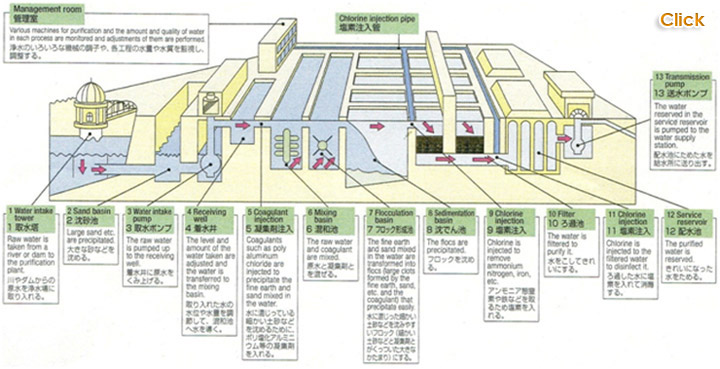The Safety of Tokyo Water: the case of the Fukushima nuclear accident
Tomoyo Shibata
1. Introduction
In Japan, the big earthquake happened last March 11 and due to the tsunami which was caused by the earthquake, the nuclear plants in Fukushima were broken down. Then a lot of radioactive materials were released in the air. Most of them were released in March,2011 and Now(July,2011) a little.
As a citizen of Tokyo, I feel uneasy about tap water of Tokyo. How does it have an influence on Tokyo Water? Is the water really safe? These questions led me to do search on Tokyo Water in the case of the Fukushima nuclear accident.
2. Background
2-1. tap water
In Japan, all drinking water comply with Drinking Water Quality Standard. The water is purified at Drinking Water Treatment Plant (DWTP) and sent to houses with water pipes. The details of DWTP in Tokyo are shown on Table 1.-1)
| Purification Plant | Plant Capacity(m³/day) | Treatment Method |
|---|---|---|
| Kanamachi | 1,500,000 | Rapid sand filtration(Partially advanced water treatment) |
| Misato | 1,100,000 | |
| Asaka | 1,700,000 | |
| Misono | 300,000 | |
| Higashi-murayama | 1,265,000 | Rapid sand filtration |
| ozaku | 280,000 | |
| Sakai | 315,000 | Slow sand filtration |
| Kinuta | 114,500 | Membrane filtration, Slow sand filtration |
| Kinutashimo | 70,000 | |
| Tamagawa | 152,500 | Slow sand filtration, Rapid sand filtration |
| Nagasawa | 200,000 | Rapid sand filtration |
| Suginami | 15,000 | Chlorine injection only |
2-2. Structure of DWTP
Rapid sand filtration is the common treatment method. First, coagulant is added to the water to precipitate fine particles. Coagulated particles are removed by precipitation and filteration. Then it is disinfected by chlorine. The details of this treatment are shown in Figure1. Additionally, some DWTP use membrane filtration, activated carbon or ozone.-1)
3. Radioactive materials in Tokyo water-2)
On 22nd March 2011, water from Kanamachi DWTP exceeded a standard of radioactive iodine. The measured value was 210Bq/kg and this was higher than the standard, 100Bq/kg.
Therefore, DWTP increased dose of coagulant and activated carbon (*1) at all DWTP. Additionally when it was raining, DWTP refrained from taking water and covered the tanks.
Furthermore, values of radioactive materials (iodine and 2 kinds of cesium (*2) are measured in DWTP every day and made public. To measure them, germanium semiconductor detectors are mainly used. Now the water is under standards or not detected (*3).
- *1) Removal of radioactive materials at DWTP3)
- With activated carbon and disinfection by chlorine, only less than 50% of iodine can be removed. In contrast, cesium absorbed to colloid is almost completely removed with coagulation and filtration, and cesium which is not absorbed, that is, ionized form is not removed in DWTP. As most of cesium in the environment is absorbed into colloid, cesium can be almost completely eliminated in DWTP.
- *2) Test items of radioactive materials
- Waterworks department publishes measured values of only iodine and cesium. However, not only iodine and cesium but also other elements including tellurium, xenon, strontium, and technetium are observed on and around the premise of the nuclear plants. Why only 2 kinds? I asked Professor Hiroaki Furumai, professor at the University of Tokyo, specialized in water supply and sewage systems (His HP: http://www.recwet.t.u-tokyo.ac.jp/furumailab/member/furumai_j.html). He is a member of the investigation committee about safety of Tokyo water.
- First, according to the proportion of observed radioactive materials in the air (show HP of High Energy Accelerator Research Organization, KEK http://www.kek.jp/quake/radmonitor/index-e.html), most of radioactive materials are iodine, cesium and tellurium. Therefore, the three kinds are important.
- Next, half-life is important because after half-life is passed, the amount of radiation becomes half. Half-life of tellurium is 3 days, iodine is 8 days and cesium is 30 years. Half-life of tellurium is short, so iodine and cesium need to be tested.
- *3) What is “Not Detected”?
- Detection limits differ from methods of measurement and properties of detectors. For example, the detection limits of iodine and cesium of DWTP in Tokyo was about 7 Bq/kg until 7th August 2011, but, since then, the limit is about 0.8 Bq/kg. (For measured values and detection limits, show http://www.waterworks.metro.tokyo.jp/press/shinsai22/index.html)
- In contrast, Tokyo Metropolitan Institute of Public Health, which measures drinking water of its building by a germanium semiconductor detector every day, displays “Not Detected” when a measured value is less than three times of the measurement error. The limit value is about 0.2 Bq/kg. (Show http://monitoring.tokyo-eiken.go.jp/monitoring/w-past_data.html)
4. Conclusion
Now measured data of radioactive materials in Tokyo water is under standards or even not detected so it can be said that Tokyo water is safe.
However, it is not easy to say that the water has no risk. First, the kind of measured radioactive materials leans on half-life and the proportion of radioactive materials released from the nuclear plants. In other words, there is no guarantee that there is no radioactive material except iodine and cesium in the drinking water. Therefore, Authorities should make it public that amount of radiation from all radioactive materials or measured values of all kinds of radioactive materials. Next, in case a large amount of radioactive materials is released from nuclear plants again, there is a high possibility that radioactive iodine concentration may exceed the standard again in the drinking water from DWTPs, because DWTPs can eliminate cesium but not all iodine. A new technology to remove iodine is needed as soon as possible.
5. Reference
-
1)「Water supply in Tokyo~Provosion of Excellent Water and High-Quality Service~Business Outline 2010」, Bureau of Water works Tokyo Metropolitan Government
-
2)Bureau of Water works Tokyo Metropolitan Government HP
-
3)小坂浩司,島崎大,浅見真理,秋葉道宏,2011,浄水プロセスにおける放射性物質の除去性能に関するレビュー.水道協会雑誌,80(4),70-76.
-
4)「Radioactive material level in tap water in Tokyo / day」
http://monitoring.tokyo-eiken.go.jp/monitoring/w-past_data.html (30/6/2011) -
5)「健康安全研究センターで測定している蛇口からの水道水、降下物に対する「ND(不検出」の考え方)
http://monitoring.tokyo-eiken.go.jp/monitoring/ND.html (30/6/2011) -
6)「高崎に設置されたCTBT放射性核種探知観測所における放射性核種探知状況」
http://www.cpdnp.jp/pdf/110509Takasaki_report_Info.pdf (30/6/2011) -
7)「環境放射線の測定結果」
http://www.kek.jp/quake/radmonitor/ (30/6/2011) -
8)「水道水における放射性物質対策中間取りまとめ」
http://www.mhlw.go.jp/stf/shingi/2r9852000001g9fq-att/2r9852000001g9jp.pdf (30/6/2011) -
9)「事業概要 H22」, 東京都水道局




